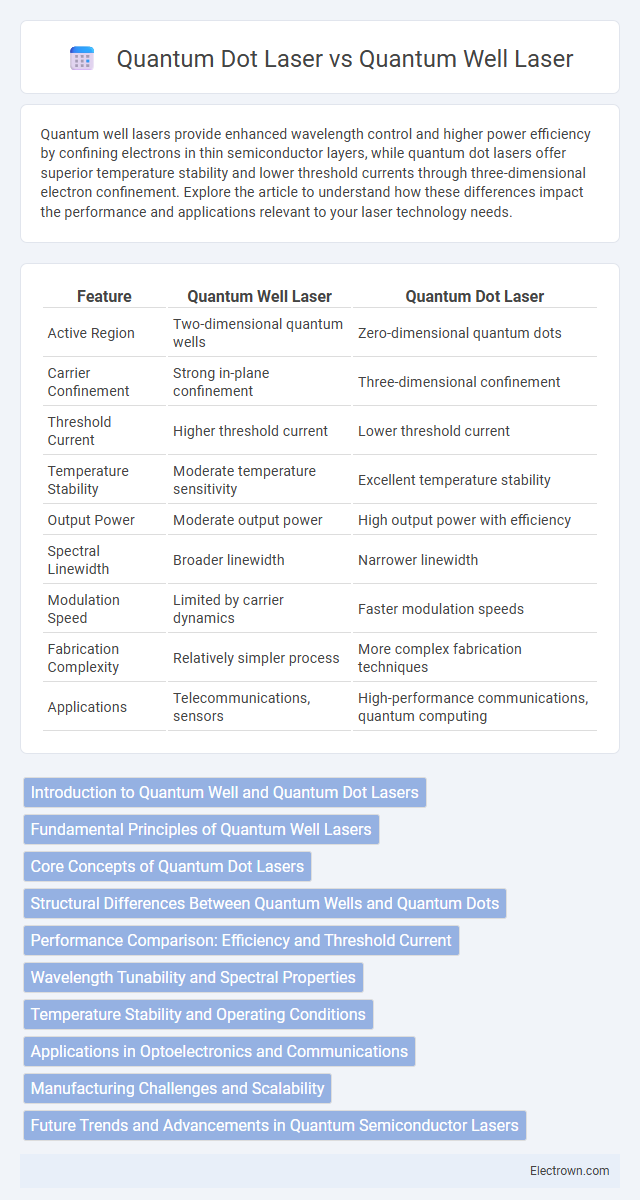Quantum well lasers provide enhanced wavelength control and higher power efficiency by confining electrons in thin semiconductor layers, while quantum dot lasers offer superior temperature stability and lower threshold currents through three-dimensional electron confinement. Explore the article to understand how these differences impact the performance and applications relevant to your laser technology needs.
Table of Comparison
| Feature | Quantum Well Laser | Quantum Dot Laser |
|---|---|---|
| Active Region | Two-dimensional quantum wells | Zero-dimensional quantum dots |
| Carrier Confinement | Strong in-plane confinement | Three-dimensional confinement |
| Threshold Current | Higher threshold current | Lower threshold current |
| Temperature Stability | Moderate temperature sensitivity | Excellent temperature stability |
| Output Power | Moderate output power | High output power with efficiency |
| Spectral Linewidth | Broader linewidth | Narrower linewidth |
| Modulation Speed | Limited by carrier dynamics | Faster modulation speeds |
| Fabrication Complexity | Relatively simpler process | More complex fabrication techniques |
| Applications | Telecommunications, sensors | High-performance communications, quantum computing |
Introduction to Quantum Well and Quantum Dot Lasers
Quantum Well Lasers use ultra-thin semiconductor layers to confine electrons and holes in two dimensions, enhancing performance by improving carrier recombination efficiency. Quantum Dot Lasers exploit nanoscale semiconductor particles that trap carriers in three dimensions, leading to superior temperature stability and lower threshold currents. These differences in quantum confinement directly impact the lasers' optical properties and device applications.
Fundamental Principles of Quantum Well Lasers
Quantum well lasers operate on the principle of confining electrons and holes within a thin semiconductor layer, creating discrete energy states that enhance optical gain and efficiency. This quantum confinement increases the recombination rate of charge carriers, enabling lower threshold currents and improved modulation speeds compared to traditional bulk lasers. Your understanding of these fundamental principles highlights the key advantages of quantum well lasers in high-speed communication and integrated photonic applications.
Core Concepts of Quantum Dot Lasers
Quantum dot lasers utilize nanoscale semiconductor particles that confine charge carriers in all three spatial dimensions, enhancing electron-hole recombination efficiency compared to two-dimensional quantum well lasers. These three-dimensional quantum dots provide discrete energy states, resulting in lower threshold currents, improved temperature stability, and narrower emission linewidths. Understanding these core concepts helps optimize your laser design for applications requiring high precision and performance in optoelectronics.
Structural Differences Between Quantum Wells and Quantum Dots
Quantum well lasers consist of thin semiconductor layers where charge carriers are confined in one dimension, creating a 2D electron gas that enables efficient light emission. Quantum dot lasers feature nanoscale semiconductor particles that confine carriers in all three dimensions, resulting in discrete energy levels and enhanced performance such as lower threshold currents and temperature stability. Understanding these structural differences helps you select the right laser type for specific applications in optoelectronics and photonics.
Performance Comparison: Efficiency and Threshold Current
Quantum dot lasers exhibit superior efficiency and lower threshold current compared to quantum well lasers due to their three-dimensional carrier confinement, which reduces non-radiative recombination and enhances gain. Quantum well lasers, with two-dimensional confinement, generally have higher threshold currents and lower efficiency under equivalent operating conditions. Choosing quantum dot lasers can optimize Your device performance, especially in applications requiring low power consumption and high-speed modulation.
Wavelength Tunability and Spectral Properties
Quantum well lasers offer moderate wavelength tunability based on well thickness and material composition, typically resulting in a narrower emission spectrum suited for applications requiring stable laser output. Quantum dot lasers exhibit enhanced spectral stability and broader wavelength tunability due to discrete energy states from quantum confinement, enabling your device to achieve precise emission control and reduced temperature sensitivity. The quantum dot's inhomogeneous broadening contributes to superior spectral properties, making them ideal for applications demanding high-performance tunability and coherent light sources.
Temperature Stability and Operating Conditions
Quantum dot lasers exhibit superior temperature stability compared to quantum well lasers due to their three-dimensional carrier confinement, which reduces carrier leakage at elevated temperatures. Quantum wells, with two-dimensional confinement, suffer from increased threshold currents and reduced efficiency as temperature rises, limiting their operating conditions. Consequently, quantum dot lasers maintain consistent performance over a wider temperature range, making them more suitable for demanding and variable environments.
Applications in Optoelectronics and Communications
Quantum Well Lasers dominate optoelectronic devices due to their high gain and efficiency, making them ideal for fiber optic communication and laser printing. Quantum Dot Lasers offer superior temperature stability and lower threshold currents, enhancing performance in high-speed data transmission and optical interconnects. Your choice between these lasers impacts the reliability and speed of communication systems in applications such as telecommunications and integrated photonics.
Manufacturing Challenges and Scalability
Quantum well lasers face challenges in maintaining uniform layer thickness and precise composition during epitaxial growth, which can limit scalability and increase production costs. Quantum dot lasers require meticulous control over nanocrystal size and distribution to achieve consistent performance, posing significant manufacturing complexity but offering better scalability potential due to improved temperature stability and lower threshold currents. Your choice of laser depends on balancing these manufacturing challenges with the desired application's scalability and performance requirements.
Future Trends and Advancements in Quantum Semiconductor Lasers
Quantum dot lasers offer superior performance in temperature stability and lower threshold currents compared to quantum well lasers, driving their growing adoption in next-generation photonic devices. Advancements in materials science and fabrication techniques are enabling higher integration and efficiency, critical for applications in optical communication and quantum computing. Your choice of laser technology will increasingly depend on requirements for device miniaturization, energy efficiency, and operational wavelength precision as these trends shape the future of quantum semiconductor lasers.
Quantum Well Laser vs Quantum Dot Laser Infographic

 electrown.com
electrown.com